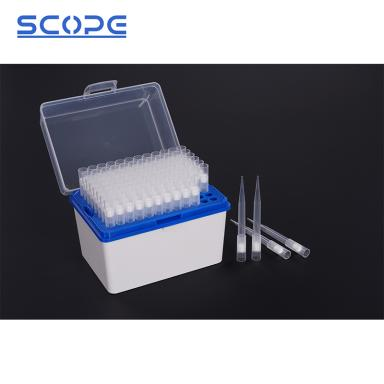Filter pipette tips are a crucial tool in any laboratory setting where precise liquid handling and contamination prevention are paramount. They go beyond the basic function of standard pipette tips by incorporating a small but mighty filter at the top. Let's delve deeper into their purpose and working mechanism.
What are Filter Pipette Tips?
Imagine a standard pipette tip, typically made of polypropylene plastic, but with a tiny hydrophobic (water-repelling) barrier inserted near the opening. This barrier, often composed of polyethylene frit, acts as a selective gatekeeper for liquids and air.
How Do They Work?
The magic lies in the filter's properties
- Hydrophobic nature: The filter repels liquids. As you aspirate liquid into the tip, the filter prevents the liquid from reaching the pipette shaft. This safeguards the internal components of the pipette from potential contamination by the sample or vice versa.
- Air permeability: While blocking liquids, the filter allows air to pass through. This ensures smooth and accurate pipetting by maintaining proper pressure balance within the tip.
Benefits of Using Filter Pipette Tips
Reduced Contamination Risk: By preventing samples or liquids from entering the pipette shaft, filter tips significantly minimize the risk of cross-contamination between samples. This is especially crucial when working with sensitive materials like:
- Nucleic acids (DNA and RNA)
- Proteins
- Cells
- Radioactive materials
- Infectious agents
- Protection for the Pipette:The filter shields the delicate internal mechanisms of the pipette from harsh chemicals, corrosive substances, or biological materials that could damage them over time. This extends the lifespan and maintains the accuracy of your pipetting instrument.
- Minimized Aerosol Formation: During pipetting, aerosols (tiny airborne liquid particles) can form. Filter tips help prevent these aerosols from entering the pipette shaft, protecting the user from potential inhalation risks and ensuring sample integrity.
Applications of Filter Pipette Tips:
Due to their enhanced protection features, filter pipette tips are widely used in various laboratory practices, including:
- PCR (Polymerase Chain Reaction): Precise and contamination-free handling of delicate DNA samples is essential for successful PCR.
- Cell Culture: Maintaining a sterile environment is critical for healthy cell growth. Filter tips prevent contamination risks during media changes or cell harvesting.
- Radioisotope Handling: Safe handling of radioactive materials requires extra precautions. Filter tips minimize the risk of radioactive contamination within the pipette.
- General Work with Sensitive Samples:Whenever working with valuable, irreplaceable, or potentially hazardous samples, using filter tips is a wise safety measure.
In Conclusion
Filter pipette tips offer a valuable layer of protection in the laboratory. By preventing contamination, safeguarding the pipette, and minimizing aerosol formation, they promote accurate, reliable, and safe pipetting practices. For any application where sample integrity and user safety are paramount, filter pipette tips are a worthwhile investment. And there is more information that we will provide you such as: Are Filter Pipette Tips Compatible With My Specific Pipette?

